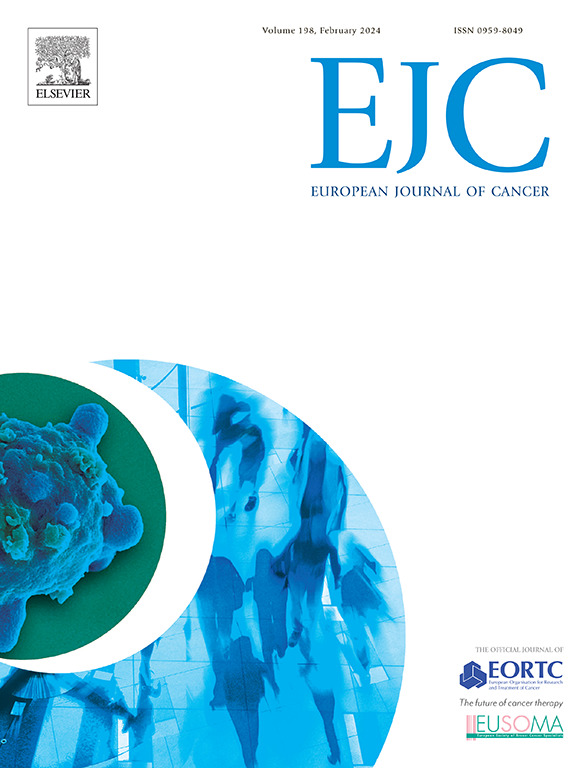原发不明的头颈癌的治疗:DAHANCA的一项IV期研究。
IF 7.6
1区 医学
Q1 ONCOLOGY
引用次数: 0
摘要
背景:原发不明的头颈部鳞状细胞癌(HNSCCUP)患者的诊断和治疗管理仍然是一个挑战。目前IV期研究的目的是评估当前丹麦指南的依从性,并评估HNSCCUP患者的治疗结果。材料和方法:对2014年至2020年期间接受治疗的DAHANCA数据库中前瞻性收集的数据进行评估。中位随访时间为6.7年。治疗包括明确的颈部清扫(dND),初始(化疗)放疗((C-)RT),颈部清扫(ND),随后进行术后(C-)RT (ND + (C-)PORT)。结果报告为局部-区域失败(LRF)、最终LRF (ULRF)、疾病特异性死亡率(DSM)、总生存期(OS)和毒性评分≥ 3的五年估计。结果:共治疗288例患者,其中254例(88 %)获得治疗意图,符合依从性评估。这些都是分配给dND (n = 60),(C) RT (n = 81)和ND + (C -)端口(n = 113)。在109例(43 %)阳性病例中,95% %的患者已知HPV/p16状态。有治愈意图的患者的5年LRF、DSM和OS分别为22 %、15 %和73 %,p16阳性患者的5年LRF、DSM和OS分别为16 %、5 %和85 %。总体指南依从性为76 %(192/254)。粘附组LRF、ULRF、DSM、OS分别为22 %、11 %、16 %、73 %。结论:该研究揭示了遵循丹麦指南的HNSCCUP患者的良好治疗结果,与其他头颈癌患者相当。观察到的指南偏差不影响结果。本文章由计算机程序翻译,如有差异,请以英文原文为准。
Management of head and neck cancer of unknown primary: A phase IV study by DAHANCA
Background
Diagnostic and therapeutic management of patients with head and neck squamous cell carcinoma of unknown primary (HNSCCUP) remains a challenge. The aim of the present phase IV study was to assess adherence to the current Danish guidelines and evaluate the treatment outcome in HNSCCUP patients.
Materials and methods
Prospectively collected data in the DAHANCA database from patients treated between 2014 and 2020 was evaluated. The median follow-up was 6.7 years. Treatment included definitive neck dissection (dND), primary (chemo-)radiotherapy ((C-)RT), neck dissection (ND) followed by postoperative (C-)RT (ND + (C-)PORT). Outcome were reported as five-year estimates of loco-regional failure (LRF), ultimate LRF (ULRF), disease specific mortality (DSM), overall survival (OS), and toxicity scores ≥ 3.
Results
A total of 288 patients were treated, of which 254 (88 %) received treatment with curative intent and were eligible for adherence assessment. These were allocated to dND (n = 60), (C-)RT (n = 81) and ND + (C-)PORT (n = 113). The HPV/p16 status was known in 94 % of patients with 109 (43 %) positive cases. The 5-year LRF, DSM, and OS for patients treated with curative intent was 22 %, 15 % and 73 %, and in patients with p16 positive disease 16 %, 5 %, and 85 %. The overall guideline adherence was 76 % (192/254). In the adherent group the LRF, ULRF, DSM, and OS were 22 %, 11 %, 16 %, and 73 %, respectively.
Conclusion
The study revealed good treatment outcome measures in HNSCCUP patients subject to the Danish guidelines, comparable to other head and neck cancer patients. The observed guideline-deviations did not affect outcome.
求助全文
通过发布文献求助,成功后即可免费获取论文全文。
去求助
来源期刊

European Journal of Cancer
医学-肿瘤学
CiteScore
11.50
自引率
4.80%
发文量
953
审稿时长
23 days
期刊介绍:
The European Journal of Cancer (EJC) serves as a comprehensive platform integrating preclinical, digital, translational, and clinical research across the spectrum of cancer. From epidemiology, carcinogenesis, and biology to groundbreaking innovations in cancer treatment and patient care, the journal covers a wide array of topics. We publish original research, reviews, previews, editorial comments, and correspondence, fostering dialogue and advancement in the fight against cancer. Join us in our mission to drive progress and improve outcomes in cancer research and patient care.
 求助内容:
求助内容: 应助结果提醒方式:
应助结果提醒方式:


